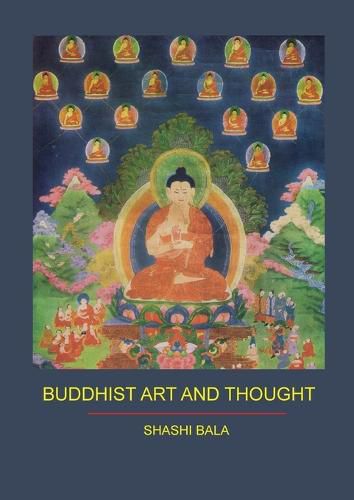Readings Newsletter
Become a Readings Member to make your shopping experience even easier.
Sign in or sign up for free!
You’re not far away from qualifying for FREE standard shipping within Australia
You’ve qualified for FREE standard shipping within Australia
The cart is loading…






This title is printed to order. This book may have been self-published. If so, we cannot guarantee the quality of the content. In the main most books will have gone through the editing process however some may not. We therefore suggest that you be aware of this before ordering this book. If in doubt check either the author or publisher’s details as we are unable to accept any returns unless they are faulty. Please contact us if you have any questions.
Buddhist Art and Thought is a kaleidoscopic canvas of cultural inter-flow among Asian countries discussing Sanskrit manuscripts from Japan, inscriptions from Southeast Asia, the texts translated into Chinese and Tibetan languages, Sanskrit as a shared heritage of Japan and SEA. The role played by Buddhist sutras in polity, transmission of philosophy, creation of innovative iconic forms, their identification and categorization, philosophic interpretations of mandalas, impact of Indian art forms on painting and sculpture, martial arts, the cult of mystical medicine, Divine guardians for defense, light symbolism, the concept of colossal images are some of the topics covered. Dhyana permeated into the lives of the people. Indian rituals and ceremonies were performed for deification and to derive sanctity and power to serve, sustain and rule. The book covers topics like Amitabha in Japan, Yoga as the Basis of Pure Land mandalas represented through Sukhavati scenes, Shingon mandalas in Japan represent levels of meditation and emergence of the world from the Great source. The philosophy of Avatamsaka-sutras, mandalas for an upward journey through meditation, the ceremonies performed in Shingon monasteries, Indian Brahmanas, deities of time and space, categorization of Bodhisattvas, similarities between art of Ajanta and mural at the Horyuji monastery are a few attractive topics.
Tantric deities of royal cults were worshipped for divine empowerment and conquering in Nepal, Tibet and Mongolia. History of monasteries in Khotan revisited through Tibetan literary sources. Suvarnaprabhasa-sutra promises to protect the kings and kingdoms. Thousands of fragments of manuscripts, and artifacts excavated from ruined monasteries highlight an era of splendor of international cultural relations.
Siddham calligraphy is still practiced in Japan. Sanskrit hymns taken to Japan were accompanied by musical notations. Japanese alphabet Katakana and Hiragana are based on the Sanskrit sound sequence.
The book skims over to the modern period highlighting contributions of 20th century scholars who strengthened cultural linkages. George Nicholai Roerich was one of the great Indologists. His life and research for Shambhala, is a symbol of aspirations for a bright future.
$9.00 standard shipping within Australia
FREE standard shipping within Australia for orders over $100.00
Express & International shipping calculated at checkout
This title is printed to order. This book may have been self-published. If so, we cannot guarantee the quality of the content. In the main most books will have gone through the editing process however some may not. We therefore suggest that you be aware of this before ordering this book. If in doubt check either the author or publisher’s details as we are unable to accept any returns unless they are faulty. Please contact us if you have any questions.
Buddhist Art and Thought is a kaleidoscopic canvas of cultural inter-flow among Asian countries discussing Sanskrit manuscripts from Japan, inscriptions from Southeast Asia, the texts translated into Chinese and Tibetan languages, Sanskrit as a shared heritage of Japan and SEA. The role played by Buddhist sutras in polity, transmission of philosophy, creation of innovative iconic forms, their identification and categorization, philosophic interpretations of mandalas, impact of Indian art forms on painting and sculpture, martial arts, the cult of mystical medicine, Divine guardians for defense, light symbolism, the concept of colossal images are some of the topics covered. Dhyana permeated into the lives of the people. Indian rituals and ceremonies were performed for deification and to derive sanctity and power to serve, sustain and rule. The book covers topics like Amitabha in Japan, Yoga as the Basis of Pure Land mandalas represented through Sukhavati scenes, Shingon mandalas in Japan represent levels of meditation and emergence of the world from the Great source. The philosophy of Avatamsaka-sutras, mandalas for an upward journey through meditation, the ceremonies performed in Shingon monasteries, Indian Brahmanas, deities of time and space, categorization of Bodhisattvas, similarities between art of Ajanta and mural at the Horyuji monastery are a few attractive topics.
Tantric deities of royal cults were worshipped for divine empowerment and conquering in Nepal, Tibet and Mongolia. History of monasteries in Khotan revisited through Tibetan literary sources. Suvarnaprabhasa-sutra promises to protect the kings and kingdoms. Thousands of fragments of manuscripts, and artifacts excavated from ruined monasteries highlight an era of splendor of international cultural relations.
Siddham calligraphy is still practiced in Japan. Sanskrit hymns taken to Japan were accompanied by musical notations. Japanese alphabet Katakana and Hiragana are based on the Sanskrit sound sequence.
The book skims over to the modern period highlighting contributions of 20th century scholars who strengthened cultural linkages. George Nicholai Roerich was one of the great Indologists. His life and research for Shambhala, is a symbol of aspirations for a bright future.